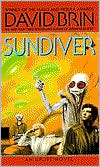Book Smarts
After lagging back a little while, I powered through two books in a short period of time. This review is the first of those. This was another break from the 700+ pages of what I now think is 8.5 point font. I finally read The Diamond Age or, A Young Lady’s Illustrated Primer by Neal Stephenson. Previously I have reviewed Cryptonomicon, and before I started doing reviews I had read Snow Crash at the behest of a friend. Before starting this one I had liked Stephenson’s books and had high hopes for this one. In fact this book was recommended by the same friend, but it took me to this point to get around to reading it. I’ll probably ramble on about it in my own way.
Now I’m torn because I want to talk about the book, but I don’t want to give too much away. Well I’ll see what happens.
The fulcrum of this novel is one John Percival Hackworth (Percival was the grail knight). He is an artifex, a master of nanotechnological design. In fact I would venture to say he is as much artist as engineer. Yes I know I am a little biased for engineering elegance being artistic. John belongs to the powerful clan of neo-Victorians. After the collapse of 20th century western society this clan eventually came to power by embracing Victorian ethics and codes of conduct. The clan tends to churn members a bit. Those that join the clan after a hard life outside tend to become the clan’s strongest members. Those born into the clan tend to be lackluster in achievements. To combat this trend in his own granddaughter, a duke commissions Hackworth to create A Young Lady’s Illustrated Primer. The “book” if you can call it that is a sophisticated interactive computer system that is designed to give a girl all the tools necessary and to teach her to take chances and become great. Hackworth, in probably one of his only criminal moments, steals a copy of the book for his daughter only to have it stolen and fall into the hands of Nell.
Nell, not sure if it ever says her last name aside from saying her brother’s, is a poor little “thete,” poor with no clan affiliation, girl. She cannot read, her mother seems to have little care for her, and her brother Harv acts as her protector and teacher, until Harv brings her the Primer. Nell has had a hard life for a 5-6 year old and the Primer begins her education. What happens then is a wild ride following the lives of several people and Nell as the fruits of Hackworth’s brilliant mind accidentally, purposefully, and subconsciously weaves a tapestry of events into being.
I quite enjoyed this book. It captured me like the other of Stephenson’s books and made me want to read it faster. The characters, the environment, and the politics of the time all mesh well together. Stephenson does a good job of creating the fantastical from the technical. It does a good job of explaining how experience and education create most of who we are as individuals. The 3 initial Primers each do something different for the girl to which they are given. The 100,000+ given to the castoffs do something different, but similar. In all it makes you wonder if Hackworth had any idea exactly what he was creating. Stephenson also continues to do some strange things with sex and descriptions that tend to throw me out of the world he has created. It’s probably more me than anything else. At least none of it seemed that unnecessarily descriptive, unlike a couple of scenes in Cryptonomicon. In all it is quite a satisfying read. I recommend it to anyone that likes similar types of books.
Labels: books, humanity, science fiction, technology






























3 Comments:
Glad you read it. I enjoyed it as well, especially the most basic teaching of computer programming by reducing it to a Turing machine.
Only question I have for you is, what did you think of the ending, no specifics, just how did you feel it ended.
It's the only sticking point for me. Probably best to discuss over a nice beer, or possibly even an even nicer whiskey.
Mmmmm, whiskey.
By Anonymous, at 3/20/2008 5:18 PM
Anonymous, at 3/20/2008 5:18 PM
I think discussion over whiskey would be a wise choice. I may begin thinking about it over a glass tonight.
By Lucky Bob, at 3/20/2008 7:03 PM
Lucky Bob, at 3/20/2008 7:03 PM
Having just recently reread it I think it definitely bears discussion over beers or whiskeys.
I liked the ending a bit better than I did Snow Crash's, but I don't dislike Stephenson's open endings generally. There was more I wanted to know, but that's how he ends every book.
I find on the most recent reading that I enjoy the first part of the book, before Hackworth goes off, to the latter half of the book. The whole bit with the theatre troupe in London is just... I don't know, weird for the sake of weird? Never been big on that.
But I do appreciate the discussion of hypocrisy between Hackworth, Finkle-McGraw, and the colonel. One of the wisest things Stephenson's ever put on the page.
By Unknown, at 4/02/2008 11:51 AM
Unknown, at 4/02/2008 11:51 AM
Post a Comment
<< Home